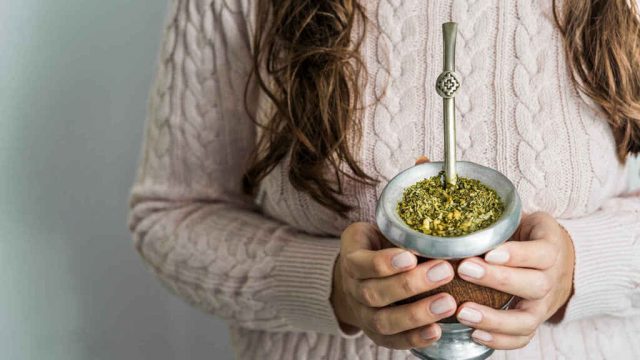Argentina celebrated the National Mate Day on November 30, a date in which they honor the most consumed infusion of the South American country and which is taken in the different regions in all the social strata, which makes it a characteristic symbol of local culture.
Although it is true that each person has their own style in the preparation of this infusion, there are general guidelines to serve a good mate. The first thing you need is the container, named after the eponymous drink, o rmatero.
It can be made of various materials, such as wood, glass or metal. However, the preferred ‘par excellence’ for Argentines is the ‘porongo’, made from a pumpkin, explains journalist Leandro Lutzky in an article published by RT.
This container, often handmade, is accompanied by its respective bombilla, metallic in most cases, although there are also bombillas made of cane. Its use is similar to that of a straw, and it is used to suck up the hot liquid.
Then, you have to place the yerba (herb) inside the mate, or pot. Its quantity depends on the preferences of the person that is going to drink the mate, although it is recommended that it should not overflow, occupying 3/4 of the total pot. Those who know, cover the hole (of the pot) with the palm of one hand and mix the herb, making sure it is inclined at about 45 degrees inside the pot. Anyway, the vast majority simply introduce the green herb, without much preamble or special techniques.
Finally, the water is poured in, at an ideal temperature of 80 degrees. It is very important that it does not boil, so as not to ruin the infusion.
When drinking mate, the bombilla serves as a filter, preventing the passage of the yerba. Likewise, several choose to spit out the first few drinks, to make sure they don’t drink the herbal fine powder, which can come in the product package.
Anyway, those who opt for a more rigorous procedure, can find many tutorials on the Internet.
A custom in Argentina with more than 500 years of history
In 2014, the Congress decided to establish the matero celebration to honor an infusion that has been consumed in the region for over 500 years, long before the existence of Argentina as a State.
The date of November 30 was established by the birth of the Guaraní commander Andrés Guacurarí, known as ‘Andresito’, the first and only indigenous governor in local history, who served in what today would be the province of Misiones.
According to historian Pablo Camogli, this aboriginal leader was characterized by having projected a market and commercial circuit for yerba mate, with the Guarani as the main actors and direct beneficiaries of the transactions. On a military level, ‘Andresito’ received the training of the revolutionary leader José Gervasio Artigas, a protagonist in the independence of the United Provinces of the Río de la Plata, and both defended a project parallel to the centralism of Buenos Aires.
Now, to celebrate this date, the National Institute of Yerba Mate (INYM) organized Mate Rock 2021, in the city of Posadas, located in the yerba mate province of Misiones. From 6 pm (local time), with thermos and mate in hand, the public will be able to enjoy the opening show, with reknown singers such as David Lebón.
Curiosities
Although many take it in solitude, when talking about this infusion we refer to a tradition linked to the act of sharing. An interesting fact for the rookies: in the rounds, if someone says «thank you» to the person who made the infusion, it is because he does not want to take anymore. Knowing these strange codes is key so as not to be taken by surprised, because in Argentina, to get together with friends and family to take mate is as common as breathing, using the same bombilla by several people.
Faced with this, within the framework of the pandemic, the health authorities lit all the alarms because it is a high source of contagion. Then, campaigns were launched encouraging each citizen to have their own Matero, so as not to mix the saliva of other drinkers between the people who are taking mate.
Among the precautions, some doctors warn that if it is very hot, it can cause tongue cancer, like any other infusion. The Argentines take mate at all times, even when they are driving. That is why, at the moment a person goes to pick up their driver’s license, the authorities insist that when you are driving, you must not drink mate, and mark it as a dangerous distractive element.
Likewise, there are numerous studies that highlight many health benefits, being used as an effective antioxidant, antidepressant and also a natural stimulant, among other qualities. In fact, when people feel sleepy, there are quite a few Argentines who wake up more with a drink of mate than with a coffee.
If this is because of the mate or another reason, the truth is that in many places it is impossible to walk without running into someone who is ‘Mateando’ (drinking mate). This is noted, above all, in the cities with access to the sea, the river or a lagoon: nothing like a rich ‘mateada‘ walking through La Costanera, looking at the horizon. In fact, fanaticism is so great for this infusion that some bars reached an absurd point in offering it as part of the menu, being a ritual that adapts to any context.
Production in Argentina
Thus, as it is to be supposed, the Latin American country is the world’s producer of mate. According to the data from INYM, since 2017, the annual production destined for the domestic market exceeded 260 million kilos, and this year it is very possible that the amount grows extensively.
As for exports, the amount ranges from 31 million and 43 million kilograms, depending on the year. As a curiosity, Syria is the main buyer of yerba mate, with 65% of the total, affirms the National Institute of Statistics and Census (INDEC).
At the regional level, consumption is not reduced only to Argentine borders. Uruguay, the neighboring country, is known for being the main ‘per capita’ drinker in the world, despite not having its own plantations, except for a few exceptions from some producers. There are also some people who drink mate in southern Brazil and, of course, in Paraguay.
In Argentina, it is consumed in 90% of all the households, or more.











